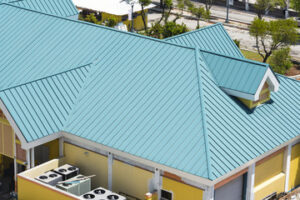Whether your roof needs repair or replacement depends on its age and condition. A roof with widespread damage may require a replacement. However, a localized problem like a leak or a few missing shingles can be repaired with repairs.

Repairs can include patching a leak, replacing shingles, and fixing flashing problems. It’s important to repair the flashing around chimneys and vents because leaks can occur there. Visit https://arthursconstructionnc.com/ to learn more.
Roof repair is an ongoing process, and the cost of repairs can vary significantly depending on the extent of damage and the type of repairs. A minor issue like a small hole or leak can be as low as $150, while a major repair or replacement could cost up to $10,000. This is why it is important to maintain regular inspections and address small problems as they occur. These preventive measures can help extend the life of your roof, saving you from expensive repairs in the future.
Some of the most common roof repairs include patching small holes, replacing shingles damaged by wind or hail, and addressing leaks caused by faulty or improper flashing. Leaks around chimneys, vents, and skylights typically require removing shingles and underlayment to properly repair the flashing and avoid leaks in the future.
The location of your home and the roofing contractor you choose will also impact the cost of your roof repair. Generally, costs are higher in urban areas due to the higher rate of labor and access to materials. You should also consider local regulations and permit fees, which may add to the overall cost.
Another important factor to consider when evaluating the cost of roof repair is the age of your roof. As asphalt shingles degrade over time, they can lose their granules and become vulnerable to cracking and leaking. This can be accelerated by exposure to harsh weather conditions. If your roof is over 20 years old and experiences frequent leaks or damage, it may be more cost-effective to replace it with a new roof.
Other factors that can affect the cost of your roof repair include maintenance, attic ventilation, and the amount of insulation installed in your home. Maintaining a well-ventilated attic can prevent moisture buildup and ice dams, which are the leading causes of roof leaks. In addition, regularly trimming overhanging trees can prevent shingle damage during storms and reduce the likelihood of leaks. You can also save on heating and cooling bills by upgrading your insulation to an energy-efficient option. Many of these upgrades are eligible for tax credits, further reducing the overall cost.
Life expectancy
Repairing your roof extends its lifespan and reduces the risk of leaks. However, you may need to replace your roof sooner than expected if it sustains severe damage or extensive deterioration. Homeowners and property managers can minimize the risks of such events by regularly inspecting their roofs. In addition, they can schedule inspections after stressful weather conditions to detect damage as early as possible. These regular inspections ensure that minor issues don’t turn into major problems later on and can help them save money in the long run by reducing energy costs and improving the value of their homes.
Roofs vary in lifespan based on the material used, the climate where they are located and how they are maintained. For example, 3-tab shingle and architectural shingle roofs last 20-30 years. Slate, tile and clay/concrete roofs last 50-70 years while metal roofs can last 40-70 years, depending on the type of metal and thickness.
The slope of a roof also impacts its lifespan. Steep slopes generally have longer life expectancies than flat roofs, which are more susceptible to water and debris accumulation. In addition, property owners should check the condition of their gutters and drainage systems to prevent water buildup on the roof.
Signs of a failing roof include curled or buckled shingles, granule loss and bald spots, as well as leaking. A sagging roof is another common indication that it’s time to replace the roof.
A professional roofer should use materials that are designed specifically for a specific roofing system and properly apply them to achieve the best results. They should follow the manufacturer’s guidelines and use high-quality materials that are backed by warranty coverage. Using quality sealants and underlayment can also increase the longevity of your roof. They will protect against moisture, ice dams and air infiltration. They will also prevent the formation of mold and fungus, which can lead to rot and leaks.
Repair options
Your roof is constantly subjected to natural wear and tear, but if you catch problems early on, you can avoid expensive repairs later. A visual inspection is the first step to spotting potential issues, but a professional check-up is also recommended. If you notice any signs of leaks, water damage, or missing shingles, call a roofing contractor immediately. Leaking roofs are the most common sign of a problem, and they can lead to severe water damage in your home.
If your roof is old and damaged, you may need to replace it entirely. However, you can prolong its life with repair options like replacing a few damaged shingles or patching a leak. A roof repair professional can also help you identify and correct underlying issues, such as poor drainage or improper ventilation.
The initial repair process begins with a thorough cleaning of the affected area. This will ensure that repair materials adhere properly to the surface of the roof. It’s important to use a cleaner that is appropriate for your roof membrane. This can be as simple as soap and water or more powerful solvents.
Leaks are usually caused by worn shingles or cracks in the membrane. These can be repaired by using a sealant or a piece of roofing membrane that is adhered over the troubled area. In addition, the professional can install additional drain points or slightly modify the slope of your roof to improve water runoff and prevent future ponding.
Depending on the type of roof, repair costs vary. Asphalt shingles are the most budget-friendly option, while metal and tile are pricier. It’s best to schedule your repair during the off-season when contractors are less busy and can offer lower rates. Regardless of the repair option you choose, it’s always a good idea to hire a reputable roofing contractor with experience and a solid reputation. They can provide you with a detailed scope of work and recommend the right solution for your needs. In addition, they can handle any insurance claims that might be required. This can be a big advantage, especially when dealing with an emergency situation.
Insurance
Homeowner’s insurance typically covers the cost of roof repair for damages that are caused by covered perils, such as high winds or fire. However, homeowners must be aware of the limits and exclusions of their policy before deciding whether or not to file a claim. In addition to the normal deductible, homeowners must also consider their insurance history when making this decision. Multiple claims may cause an insurer to raise your premium or even cancel your coverage.
In most cases, homeowners should file a claim if their roof is damaged by a peril covered by their homeowner’s policy. However, they should also carefully weigh the pros and cons of filing a claim. For example, if the damage is not significant and the repair costs are less than their deductible, they may be better off paying for repairs out of pocket. This will also avoid having their insurance premiums raised or cancelled.
A common type of roof damage is caused by falling debris during severe weather conditions. Most homeowner’s policies cover this type of damage, but it is important to check with your insurance agent to be sure that yours does. In addition, many homeowner’s policies do not cover damage that results from general wear and tear or neglect.
Another common type of roof damage is caused by the buildup of water infiltration. This is often caused by a faulty roof or by failing flashing. It is often best to seek a professional roofing contractor to fix this problem, as it can lead to leaks and other serious problems.
In some cases, a roofing company can negotiate with the insurance provider to get your roof repaired. They will submit a contract to the insurance company detailing the work to be done, including timelines, labor and materials, potential change orders, payment details, and other key factors. Make sure the contract is in writing and sufficiently detailed before any work begins. Also, be sure to use a roofing company with experience dealing with insurance providers. Lastly, do not be afraid to ask for legal advice from an attorney specializing in insurance claims if needed.

